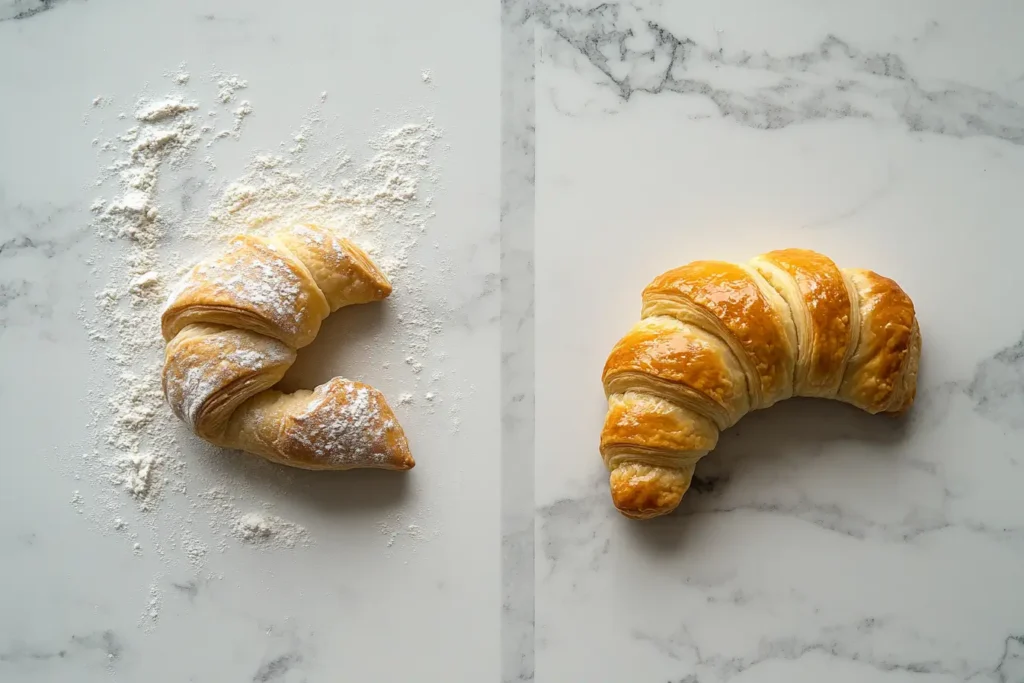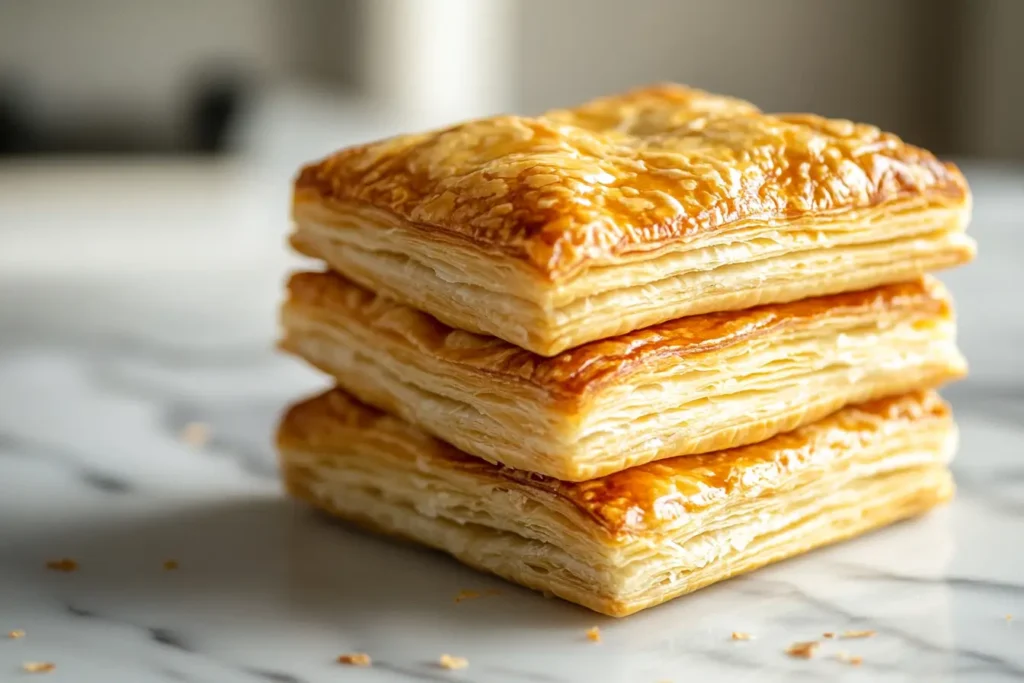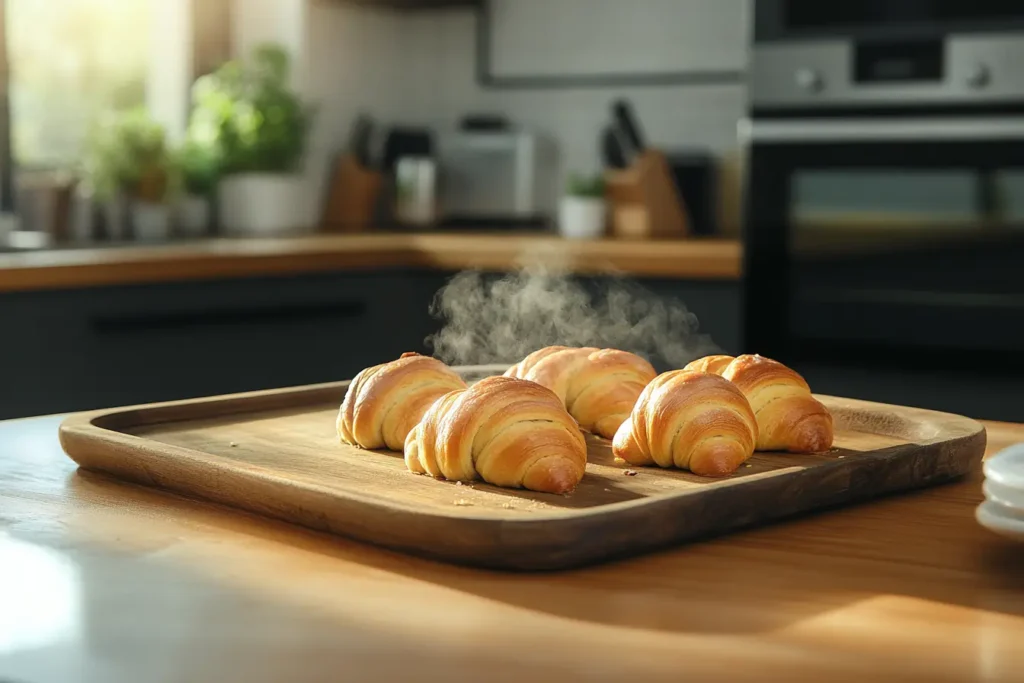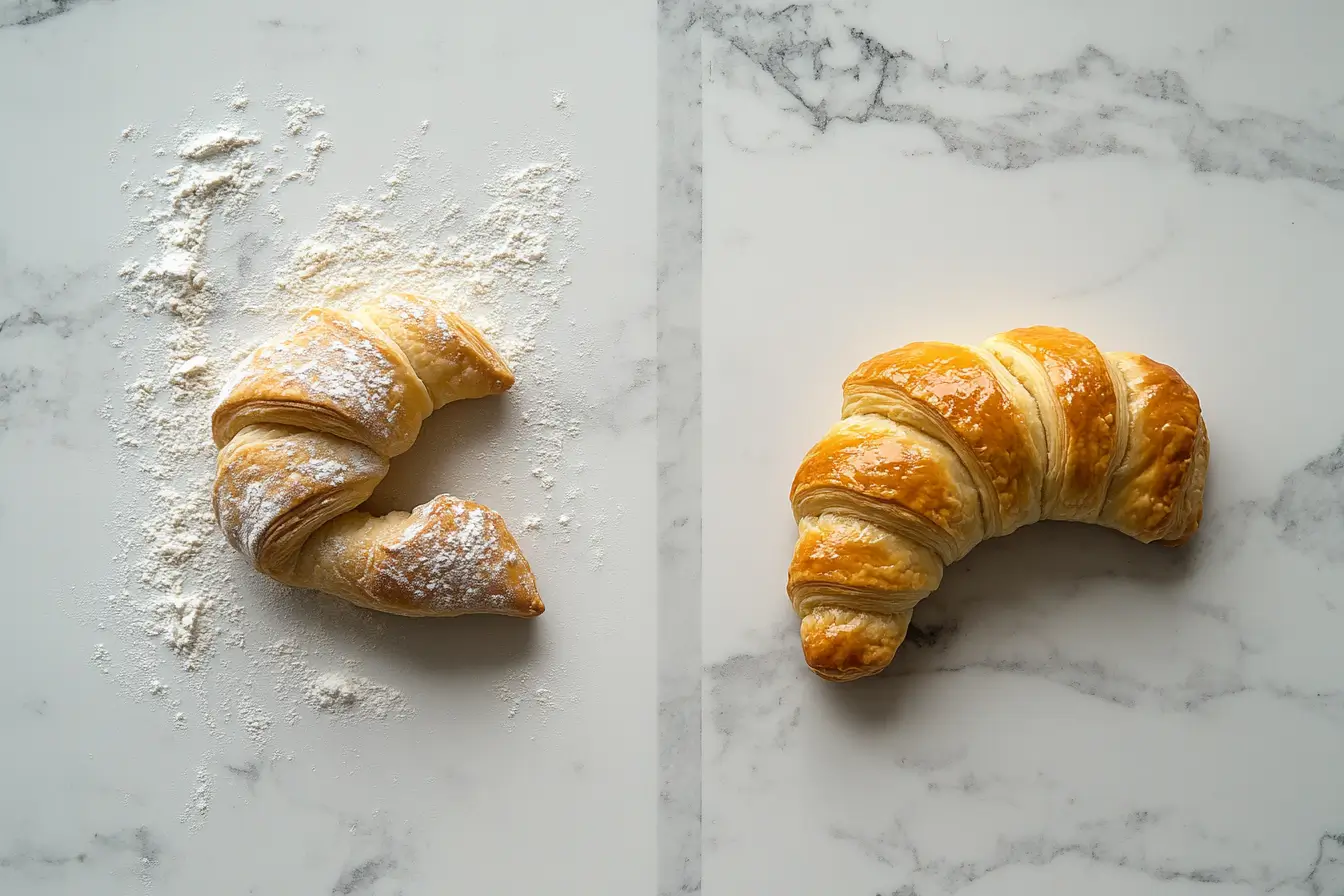
Puff pastry vs crescent rolls—when you walk down the frozen aisle or peruse the baking section, you’ve probably seen them sitting side by side. They might look similar at first glance—flaky, golden, and perfect for both savory and sweet recipes. But are they really the same thing? 🤔 Let’s dive into the buttery layers of these two doughs and uncover their secrets.
Introduction to Puff Pastry and Crescent Rolls
Before we get into the nitty-gritty of whether these two are the same or not, let’s lay a foundation. Understanding what puff pastry and crescent rolls actually are will help us differentiate them better.
What is Puff Pastry?

Ah, puff pastry—the elegant, buttery star of countless French recipes. Puff pastry is a light and flaky dough made through a labor-intensive process of folding and layering butter and dough repeatedly. This process is called “lamination.”
When baked, the butter between the layers evaporates, creating steam that puffs up the dough (hence the name). The result? A beautifully crispy and airy texture that feels like a bite of heaven. 😍
Popular Uses of Puff Pastry:
- Classic desserts like Napoleons and palmiers.
- Savory pies and tarts such as beef Wellington or spinach puffs.
- Quick snacks like cheese twists or mini quiches.
What are Crescent Rolls?

Crescent rolls, on the other hand, are the more approachable sibling of puff pastry. They come pre-rolled in a tube, often in the refrigerated section, and are ready to bake right out of the package. Crescent rolls are made from yeast-based dough, giving them a slightly denser, bread-like texture compared to puff pastry.
The signature crescent shape? It’s achieved by rolling the dough into triangles and curling them up—simple and charming, just like the rolls themselves! 🥐
Popular Uses of Crescent Rolls:
- Breakfast staples like crescent roll sausage wraps.
- Desserts such as apple turnovers or Nutella crescents.
- Quick appetizers like pigs in a blanket or crescent roll pizza bites.
Key Differences Between Puff Pastry vs Rolls
Now that you have a clearer idea of what these two are, let’s get into the juicy details of how puff pastry and crescent rolls differ. Spoiler alert: They’re not the same! 😄
Ingredients Comparison
First things first—what goes into the dough? Puff pastry is made with a simple combination of flour, butter, water, and salt. The high butter content is what gives it its iconic flakiness.
Crescent rolls, however, have a longer ingredient list. In addition to flour and butter, they contain yeast, milk, and sometimes sugar, giving them a softer and slightly sweet flavor profile.
Texture and Layering
Puff pastry is all about those layers! When baked, you can see (and feel) the delicate sheets of dough separated by air pockets. Crescent rolls are fluffier, with a more cohesive structure—think of them as the soft middle ground between bread and pastry.
“Puff pastry is like wearing a designer gown to a party, while crescent rolls are your go-to comfy jeans that still look cute.”
Cooking and Baking Techniques
Cooking with puff pastry requires a bit of skill. You need to keep the dough cold and handle it gently to preserve its layers. Crescent rolls, on the other hand, are more forgiving. They’re designed for quick prep and can be shaped, stuffed, or twisted without much hassle.
Puff Pastry vs Rolls: Common Misconceptions
If you’ve ever thought puff pastry and crescent rolls were interchangeable, you’re not alone. Let’s clear up some of the confusion surrounding these two doughs.
Why People Confuse Them
At first glance, both puff pastry and crescent rolls appear similar—they’re both golden, flaky, and versatile. But looks can be deceiving! While crescent rolls mimic the layered texture of puff pastry, their structure and taste are worlds apart.
Similarities That Lead to Confusion
Sure, both doughs can be used for sweet or savory recipes, and they’re both incredibly delicious. But beyond that, the similarities are more surface-level. If you’ve ever tried to substitute one for the other, you know the results can be… well, interesting. 😅
“Think of it this way: Puff pastry is a high-maintenance friend who needs constant attention, while crescent rolls are the laid-back buddy who’s always ready to hang out.”
Uses and Applications in Cooking
Now that we’ve sorted out their differences, let’s talk about how to use puff pastry and crescent rolls in the kitchen. Spoiler: Both are awesome in their own ways!
Dishes Made with Puff Pastry
Puff pastry’s airy texture makes it perfect for recipes where the dough needs to shine. Popular dishes include:
- Savory: Chicken pot pie, salmon en croute, or cheese straws.
- Sweet: Cream horns, mille-feuille, or fruit tarts.
Dishes Made with Crescent Rolls
Crescent rolls are the ultimate convenience food, ideal for quick and easy recipes. Here are some ideas:
- Savory: Taco ring, ham and cheese roll-ups, or spinach-artichoke bites.
- Sweet: Cinnamon sugar crescents, cherry pie bites, or chocolate-filled crescents.
Substituting One for the Other
Here’s the golden rule: While puff pastry and crescent rolls can sometimes be used interchangeably, it’s not always a perfect swap. Puff pastry works better in recipes requiring a light, crispy texture, while crescent rolls excel in recipes needing a soft, bready base.
Nutritional Comparison of Puff Pastry and Crescent Rolls
Curious about which dough is healthier? Let’s break it down. 🥗
Caloric Content
Puff pastry is higher in calories and fat, thanks to its butter-rich layers. Crescent rolls are a bit lighter, though they still pack a decent amount of fat and carbs.
Fat and Carbohydrate Differences
If you’re watching your fat intake, crescent rolls might be the better choice. However, puff pastry’s higher fat content comes from butter, which is more natural compared to the processed oils in some crescent roll brands.
Gluten-Free and Healthier Alternatives
Both puff pastry and crescent rolls contain gluten, but there are gluten-free versions available for each. Brands like Schär and Pillsbury have you covered!
Troubleshooting Common Problems in Puff Pastry vs Rolls Recipes
Baking is an art and a science, and even seasoned bakers occasionally run into issues with their dough. Puff pastry and crescent rolls, though delightful, each come with their own quirks. Let’s tackle the most common problems and how to solve them, so your creations turn out perfectly every time.
Why Does Puff Pastry Not Rise?
One of the defining features of puff pastry is its beautiful, flaky layers. But what happens when those layers fall flat, literally? Puff pastry not rising can be traced back to a few key reasons:
- Warm Dough: Puff pastry relies on cold butter to create steam in the oven. If the butter melts before baking, the layers collapse.
- Improper Rolling: Overworking the dough or rolling it unevenly can prevent it from rising evenly.
- Insufficient Oven Temperature: Puff pastry needs high heat (around 400°F) to rise properly. A cooler oven won’t create the steam needed for lift.
Solutions:
- Always keep the dough chilled while working with it. If it feels soft or sticky, refrigerate it for 15–20 minutes.
- Roll the dough gently and evenly to preserve the layers.
- Preheat your oven thoroughly to ensure it’s at the correct temperature before baking.
“Cold butter is the engine that drives puff pastry’s puff—if it melts too soon, you’re left with a flat tire.” 🚗
How to Prevent Crescent Rolls from Becoming Dense
Crescent rolls are all about that soft, airy texture. But sometimes, they come out heavy or chewy. Why? Here are the usual suspects:
- Over-handling the Dough: Kneading or shaping crescent roll dough too much can knock out the air and lead to a dense texture.
- Under-proofing: If the dough doesn’t rest long enough before baking, it won’t rise properly.
- Incorrect Baking Temperature: Like puff pastry, crescent rolls need a properly heated oven to bake evenly.
Solutions:
- Handle the dough with care. Avoid pressing or kneading it more than necessary.
- Allow the dough to proof for the recommended time to let the yeast do its job.
- Follow the baking instructions closely, including preheating the oven to the specified temperature.
Pro Tip: Think of crescent roll dough like a sleepy toddler—it needs gentle handling and plenty of rest to shine. 💤
Common Mistakes When Working with Puff Pastry
Even experienced bakers can fall into these puff pastry traps. Let’s make sure you don’t!
Overloading with Fillings
Puff pastry can only handle so much before its delicate structure gives way. Too much filling can lead to soggy, undercooked dough.
Fix: Use just enough filling to enhance the pastry without overwhelming it. Less is more when it comes to puff pastry.
Skipping the Docking Process
Docking (pricking the dough with a fork) helps control puff pastry’s rise, especially in recipes where you want a flat base.
Fix: Dock the dough before adding toppings or fillings for a more even bake.
Not Thawing Properly
Frozen puff pastry needs to be thawed before use, but doing it incorrectly (like microwaving) can ruin the texture.
Fix: Thaw puff pastry in the refrigerator for a few hours or overnight to ensure it stays cold but pliable.
Common Mistakes When Working with Crescent Rolls
Crescent rolls are more forgiving than puff pastry, but they’re not foolproof. Avoid these common pitfalls:
Over-rolling or Reshaping the Dough
Constant reshaping can make the dough tough and chewy.
Fix: Roll and shape the dough just once, and avoid unnecessary adjustments.
Baking Too Close Together
Crescent rolls expand as they bake, so crowding them on a baking sheet can result in uneven cooking.
Fix: Space rolls at least 1–2 inches apart on the baking sheet to allow for proper air circulation.
Using Old or Expired Dough
Crescent rolls rely on active yeast for their rise. If the dough is expired, it won’t rise as intended.
Fix: Always check the expiration date and use the dough while it’s fresh.
Tips for Storing and Freezing Puff Pastry and Crescent Rolls
Sometimes you want to prep ahead or save leftovers. Here’s how to properly store and freeze your doughs to maintain their quality:
Puff Pastry:
- Unbaked Dough: Wrap tightly in plastic wrap, then place in an airtight container or freezer bag. Store in the fridge for up to 3 days or freeze for up to 3 months.
- Baked Puff Pastry: Keep in an airtight container at room temperature for 1–2 days. To refresh, reheat in the oven for a few minutes.
Crescent Rolls:
- Unbaked Dough: If still in its original packaging, store in the refrigerator until the expiration date. If opened, wrap tightly and use within 24 hours.
- Baked Crescent Rolls: Store in an airtight container at room temperature for up to 3 days. Reheat in a low oven to restore softness.
“A little prep today can save you a ton of time tomorrow. Proper storage is the gift that keeps on giving.” 🎁
Expert Tips for Perfect Puff Pastry and Crescent Roll Creations
Ready to take your baking to the next level? These tips will help you create bakery-worthy treats every time. ✨
Choosing the Right Dough for Your Recipe
- Use puff pastry for recipes where flakiness and crispiness are key, such as tarts, palmiers, and turnovers.
- Opt for crescent rolls in recipes requiring a soft, bread-like texture, like wraps or stuffed rolls.
Getting Creative with Fillings and Flavors
- Puff Pastry: Experiment with fillings like goat cheese and caramelized onions for savory recipes, or Nutella and strawberries for sweet ones.
- Crescent Rolls: Try stuffing with ham and cheese, scrambled eggs, or apple pie filling for a delicious twist.
Perfecting the Finish
- For puff pastry, brush with an egg wash (a mix of beaten egg and water) for a golden, glossy finish.
- For crescent rolls, sprinkle with coarse sugar for sweetness or sesame seeds for a savory touch.
Frequently Asked Questions About Puff Pastry vs Rolls
When it comes to puff pastry and crescent rolls, many bakers have questions about how they compare, how to use them, and when to substitute one for the other. Let’s dive into some FAQs to clear up the confusion while weaving in some helpful related resources.
Can You Use Crescent Rolls Instead of Puff Pastry?
Crescent rolls can sometimes work as a substitute for puff pastry, but the texture and structure will be noticeably different. Puff pastry is light, crisp, and flaky, while crescent rolls are soft, slightly chewy, and bread-like. If your recipe calls for puff pastry’s signature crispiness, such as in elegant puff pastry dessert recipes, stick with the original. For simpler dishes like stuffed rolls or casual appetizers, crescent rolls can save time and effort.
What’s the Difference Between Rough Puff Pastry and Crescent Rolls?
Rough puff pastry, like traditional puff pastry, is made with layers of butter and dough but involves fewer folds, making it slightly easier to prepare. Crescent rolls, on the other hand, are a yeast-based dough that isn’t laminated at all. If you want to explore the differences between rough puff and other types of pastry, check out this guide on types of puff pastry.
How Can I Get My Puff Pastry to Turn Out Perfectly?
Puff pastry can be intimidating, but mastering it is worth the effort. The key is keeping the dough cold, using a hot oven, and handling it gently to preserve the butter layers. For more tips, you might find this detailed guide on how to pre-bake puff pastry helpful—it explains how to achieve that perfectly crispy texture every time.
Are Crescent Rolls Gluten-Free?
Most crescent rolls are not gluten-free because they rely on wheat-based flour. However, some brands offer gluten-free alternatives. If you’re interested in experimenting with pastry recipes that meet dietary needs, start by exploring gluten-free adaptations of common recipes or take a look at broader articles like puff pastry dessert recipes, which can guide you to create inclusive treats.
Conclusion: Puff Pastry vs Rolls – Know Your Dough
To wrap it up, puff pastry and crescent rolls are distinct in their structure, texture, and uses. Puff pastry is all about creating layers of buttery, flaky goodness, while crescent rolls provide a soft, versatile dough that’s great for quick recipes. The key is understanding the strengths of each and using them to their full potential.
Whether you’re crafting an intricate pastry or whipping up a fast appetizer, both doughs have their time and place. So, experiment, learn, and most importantly, enjoy the process—and the results!
“Good baking isn’t just about the ingredients; it’s about knowing how to make the most of them. Dive in and let your creativity rise!” 🥐

